|
Volume 13 Number 1
Editors: Li-Yu Hung Li-Hua Chen
|

|
|
|
|
|
|
|
Articles
Abstract | PDF Full Text | How to Cite
Development of competency-driven materials and instructional modules for grade 1-12 arts domain
Abstract
Textbooks are integral to teaching practices and are important mediums for teachers to transform curriculum guidelines into an experiential curriculum. This paper explores the principles of approaches to developing art competency- driven materials through the following three instructional modules: 1.“Me? Me! We ...,” which promotes the application of digital technology among elementary schools; 2.“Discover the Beauty of Taiwan,” which focuses on the esthetic education of junior high school learners; 3.“Design Thinking of Making Lamps,” which integrates arts with math, physics, and health and nursing subjects for senior high school learners. We adopted the design-based research (DBR) method comprising five steps: preparation, design, implementation, evaluation and modification, and publishing. This study proposes suggestions for art teachers and textbook editors’ to help them transform curriculum guidelines of the art domain and develop art competency-driven principles, aesthetic design principles of textbooks, and trial teaching.
APA Format
Huang, C.-H., & Hung, Y.-S. (2020). Development of competency-driven materials and instructional modules for grade 1-12 arts domain. Journal of Textbook Research, 13(1), 1-33.
|
|
|
Abstract | PDF Full Text | How to Cite
Text structures and complexity of junior high school geography textbooks
Abstract
Reading textbooks is the most direct means of obtaining knowledge. Geography highlights the interactions between people and environment and spatial variability, all of which present crucial information for cultivating future citizens. However, geography textbooks are not paid sufficient attention in Taiwan. Most textbook analyses mainly focus on history or civics and society; moreover, the analysis mostly concerns conceptual knowledge and the ideology underpinning subject contents. The current study examined the text structures of secondary geography textbooks through content analysis. The definition and classification of text structures were concluded from previous studies which provided the framework for this study. The distribution and combination of text structures and their variations were also explored. The study findings are as follows: First, the majority of the main structures in secondary geography textbooks were descriptions, followed by problem/solution. Cause/effect, compare/contrast, and sequence structures were common in substructures. Second, text structures were complicated and existed in various combinations. However, complicated structures were often expanded on the basis of basic ones. Third, the complexity of text structures varied with grade levels, and the structure for ninth grade was the most complicated. Finally, several conclusions and suggestions were presented based on the study findings.
APA Format
Wang, H.-H., & Lin, C.-N. (2020). Text structures and complexity of junior high school geography textbooks. Journal of Textbook Research, 13(1), 35-73.
|
|
|
Abstract | PDF Full Text | How to Cite
Features of grade 7 biology textbook questions explored using the framework for PISA scientific literacy assessment
Abstract
This study used the framework for Programme for International Student Assessment (PISA) 2015 scientific literacy assessment, which analyzed parts of context, knowledge, and competence in each textbook question to investigate the features of questions in the seventh-grade biology textbooks and compare the differences among the three textbook versions. The results indicated that more than 90% of the textbook questions in all three versions assessed the competence of explaining scientific phenomena; however, few assessed the competences of evaluating and designing scientific enquiry and interpreting data and evidence scientifically. Moreover, approximately 90% of the questions in all three versions were designed to test students’ content knowledge, and only a few tested their procedural and epistemic knowledge. Decontextualized questions accounted for 70% and mainly appeared in the assessment sections. The questions with personal context accounted for merely 10%-20%, and those with local and global contexts were rare. The results revealed that the main purposes of these textbooks were transmission, understanding, and verification of content knowledge rather than development of scientific competences. Textbook developers should design fewer questions requiring application of content knowledge, and instead, design more contextualized questions that make learners apply diverse knowledge and develop multiple competences.
APA Format
Yang, W.-R., & Lin, S.-F. (2020). Features of grade 7 biology textbook questions explored using the framework for PISA scientific literacy assessment. Journal of Textbook Research, 13(1), 75-106.
|
|
|
Textbook Review
PDF Full Text | How to Cite
APA Format
Chen, L.-T. (2020). A review of competence-based textbooks for junior high school social studies: History. Journal of Textbook Research, 13(1), 107-118.
|
|
|
PDF Full Text | How to Cite
APA Format
Jong, H.-M. (2020). A review of competence-based textbooks for junior high school social studies: Civics and society. Journal of Textbook Research, 13(1), 119-128.
|
|
|
Book Review
PDF Full Text | How to Cite
APA Format
Ku, Y.-M. (2020). Review of the book Literacy beyond text comprehension: A theory of purposeful reading, by Britt, M. A., Rouet, J.-F., & Durik, A. M.. Journal of Textbook Research, 13(1), 129-140.
|
|
|
Manuscripts and all editorial correspondence should be sent to:
4F, 179 Sec. 1, Heping E. Rd., Daan Dist., Taipei City 106011, Taiwan (R.O.C.)
E-mail:
ej@mail.naer.edu.tw










